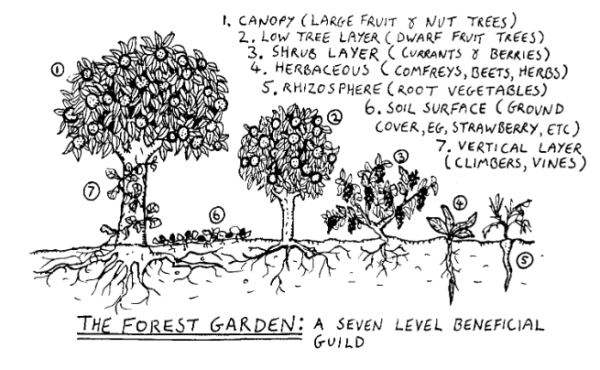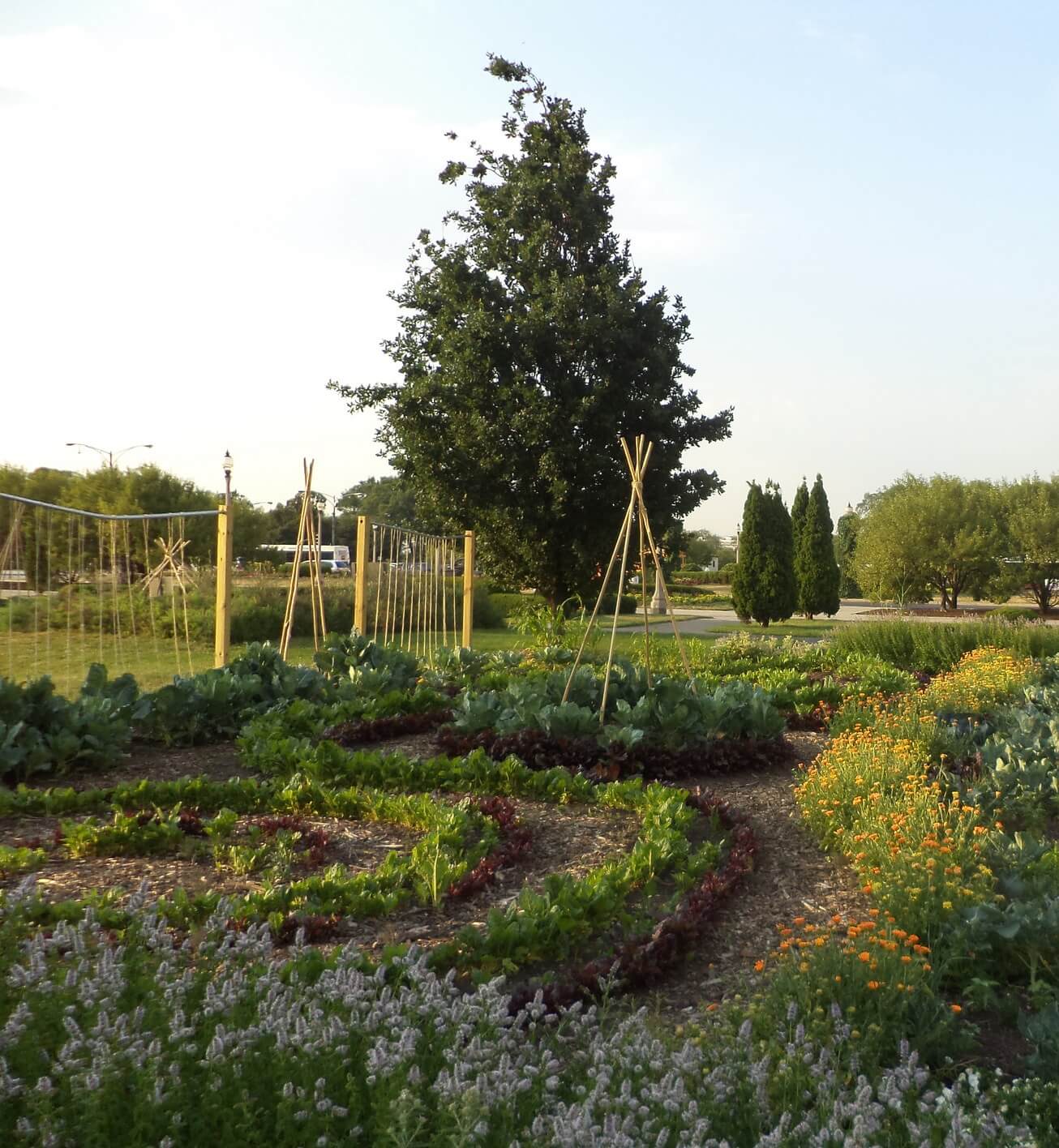What if you could turn your yard into an edible landscape with fruits, vegetables, and herbs? Edible landscaping, also known as foodscaping, brings more homegrown foods into your life while beautifying your home landscaping. And it’s easier than you think! While a lush green lawn is lovely in its own way, edible landscaping is, as gardening expert Rosalind Creasy says, “a much more noble use of the soil.”
What Is Edible Landscaping?
Edible landscaping is using vegetables and fruits instead of ornamental plants and grasses to landscape your yard. So, kinda what it sounds like. Grounded in the tradition of the Victory Gardens of World War II, edible landscaping allows you to keep your yard green and growing while enjoying a delicious harvest.
Depending on your needs, almost any food plant can be used as edible landscaping. Vining plants like passion flower, squashes, and melons would be great for fencing around the yard. Alternatively, fruit trees like cherry, fig, elderberry, and apple might be nice for edging the property.
Some plants are more beautiful than others – like towering, purple-flowered artichokes or frilly asparagus plants along walkways, bright nasturtiums or hearty mint as ground cover, or tall sunflowers along the property line. Edible landscaping allows you to free yourself from the limitations of row or garden-box growing and turn the whole yard into a garden.
Depending on your climate, needs, and abilities, you might choose to plant mostly perennials like fruit and nut trees, berries, asparagus, and other shrubs, or annuals like tomatoes, peas, and root crops. Perennials will provide you with a bounty of fresh fruits and veggies for years, while annuals you’ll need to regrow each year. So, depending on how you’re wanting to organize your garden and how often you’re wanting to replant seeds, you’ll want to consider using perennials, annuals, or a combination of both.
Modern Farmer has an excellent breakdown of how to craft a “food forest” using different levels of space to create a garden that utilizes space most efficiently. Their list also includes less-common edible foods.
Benefits Of Edible Landscaping
There are innumerable benefits to edible landscaping. The main benefit is getting to use your yard as a productive space to grow nutrient-dense, super local, yummy fruits, vegetables, and herbs. And as with any gardening you do at home, you get to try a range of foods that might not be readily available (or might be very expensive) at your local stores, like turnips and cauliflower, broccoli leaves, nasturtiums, edible flowers, and more.
By growing at home, you’re helping to improve the local ecosystem by attracting bees, butterflies, birds, and other beneficial pollinators to your garden. Hopefully, you’re also inspiring your neighbors to do the same!
Growing food (or really any plants) helps connect you with nature in a powerful way. Whether you’re nurturing a sprout into a full plant, weeding a garden, or pruning a fruit tree to be abundant, connecting with plants and nature is deeply grounding. Nourishing your body with foods that you’ve cultivated is deeply satisfying, too.
Plant Options For Edible Landscaping
As with any gardening endeavor, the types of plants you can grow in your edible yard depend on your microclimate and local climate zone. These are usually referred to as USDA zones and can be a large determining factor, especially when it comes to shoulder seasons (early spring and late autumn). In some cases, your hyper-local front yard garden ideas may be constrained by local zoning laws, so be sure to look into it before you start digging or buying new starts!
But assuming your local city and town is hip to the idea of self-sufficiency, your edible landscaping is really just dependent on your needs. For example, how many people you want to feed and which foods you wish to grow.
My backyard is filled with vining plants like passionflower and Okinawan sweet potato, as well as sturdy brassicas like collards and kale. My garden reflects exactly what I want to eat, and as such, I choose not to grow things like chard, arugula, or turnips. It’s not that I can’t grow them, it’s just that I don’t prefer eating them.
Edible Landscaping For USDA Zones 6-8
Oregon State Extension has an excellent list of the types of plants that you can grow in your yard. They break down their list by vines, shrubs, small trees, and ground covers. These are – of course – plants that would grow best in USDA Zones 6-8, those with mild temperatures:
- Vines: Grapes, cucumbers, kiwi, raspberry, marionberry
- Shrubs: Blueberry, tomato, salmonberry
- Small Trees: Apples, elderberry, fig, persimmon
- Groundcovers: strawberries, lettuce, chard, kale
Edible Landscaping For USDA Zones 2-5
If you live in colder zones (2-5), your edible landscaping might include the following:
- Trees: Apples, cherries, plums, apricots, and peaches – these fruits can handle freezing temperatures, and will bloom in the spring with lovely blossoms, and then produce fruit in the early to late summer months.
- Ground cover: Lettuces and herbs will grow throughout the year, and kales and other brassicas will thrive until at least the first frost, if not longer. Arugula, spinach, and chard will do well all season, and rainbow chard will bring a lovely pop or orange, pink, and yellow to the garden. Carrots, kohlrabi, and turnips can grow 1-2 feet of greens above ground and add to ground cover and edging.
- Vines: Peas and beans are excellent for growing along fences, pillars, and rows.
- Herbs: Most herbs are quite easy to grow in cooler climates, although the growing season is shorter. Grow extra in the summer months and then dry your herbs for cooking all winter.
Edible Landscaping For USDA Zones 9 and Up
Edible landscaping in warmer zones (9 and above) might look something like this:
- Trees: Lemon, lime, orange, and other citrus trees, peaches and apricots (if it’s not too hot).
- Ground cover: Lettuces and herbs in cooler months (spring and autumn), strawberries during the growing season. Kales, collards, broccoli, and cauliflower will do great in the shoulder seasons, but hot summers might be too hot.
- Vines: Melons, squashes, cucumbers, and pumpkins of all sorts, beans in the spring for early climbers on poles and fencing. Passionflower is a hardy, prolific vine that will produce gorgeous flowers (but will only fruit in very warm climates).
- Herbs: Basil, mint, oregano, sage and other herbs will grow quite well through a good part of the season.
The best time to start planning your edible yard or personal food forest is late fall: You’ll have time to prepare the ground before the winter, and once winter comes, you can buy bare root crops to get the edible landscaping underway.
Mapping out your property (and knowing the sun and wind patterns) will be helpful as you plan. So get some paper, a seed catalog, and get sketching!












































This is the first article I’ve read on the topic and it is direct and to the point. Well written, clear and laid out beautifully.
I bought Edible Landscaping by Rosilind Creasy, online this morning and here you are mentioning her in your opening paragraph. I immediately knew I was in good hands.
Thank you,
Mitch
What a very well written post thank you for educating us on this content. Very detailed and even with bylwas and USDA zones you covered it all. This was a great read!
I’ve been trying to find the perfect blog as far as edible landscaping is concerned, and it seems I’ve finally come across the right page. This is precisely what I was looking for! I’m glad I came across it.
Hello, We are the Garden Society of Escondido located in Escondido, California a homeowners association of 242 homes with relatively large back and front yards. We are starting a series of articles on Edible Landscaping and Foodscaping in our monthly newsletter. After reading this excellent article, we are asking permission to reprint excerpts into our Newsletter. Please allow us and promote the trend of edible landscaping in San Diego County, California.
Photo/Attachment:
Hi there! So exciting to see the education of food forests. My husband and I are owners of an edible landscaping business in South FLorida, Trugreens Landscape Designs, LLC. I am excited to share some of the plants we have come across that grow great in zone 9 and up that are a bit more unheard of, but delicious and densely packed with nutrients.
Okinawa Spinach, Malabar Spinach, Longevity Spinach, Cranberry Hibiscus, Taro root, and sweet potato ground cover.
So happy to be a part of this movement and connect with like-minded individuals!
Very nice well written article on editable landscaping ps. I love your photos!!